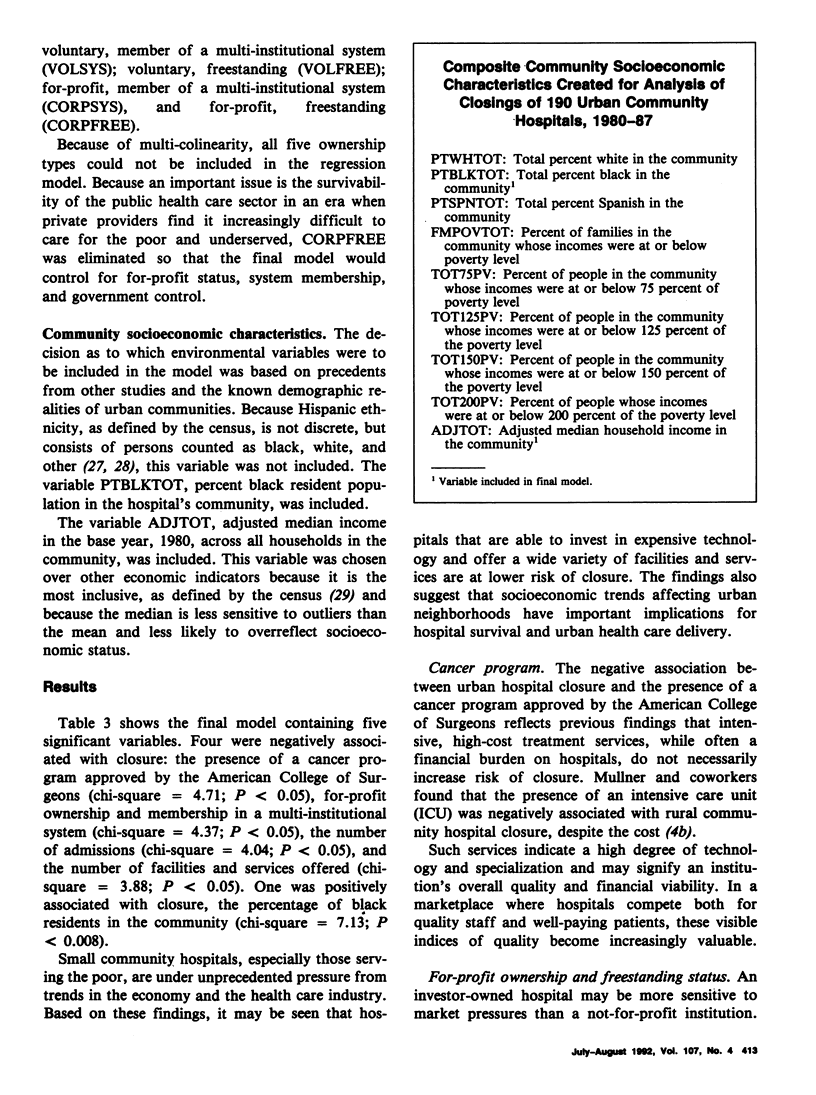Abstract
Characteristics of 190 urban community hospitals that were closed during the period 1980-87 and characteristics of the communities that they served were analyzed and compared to a control group of 380 urban hospitals that remained open. A negative association was found between hospital closure and four hospital characteristics: the presence of a cancer program approved by the American College of Surgeons, the combined characteristics of for-profit status and membership in a multi-institutional chain, the number of admissions, and the number of facilities and services offered. A positive association was found between hospital closure and the percentage of black residents in the community. These findings are discussed in the context of political and economic trends in health care and urban development. Implications for future research are noted, including managerial strategy for hospital administrators and the socioeconomic implications of hospital survival in declining urban communities.
Full text
PDF







Selected References
These references are in PubMed. This may not be the complete list of references from this article.
- Bodenheimer T. S. The fruits of empire rot on the vine: United States health policy in the austerity era. Soc Sci Med. 1989;28(6):531–538. doi: 10.1016/0277-9536(89)90247-5. [DOI] [PubMed] [Google Scholar]
- Dallek G. The loss of hospitals serving the poor. Health Serv Res. 1983 Winter;18(4):593–597. [PMC free article] [PubMed] [Google Scholar]
- Hayes-Bautista D. E., Chapa J. Latino terminology: conceptual bases for standardized terminology. Am J Public Health. 1987 Jan;77(1):61–68. doi: 10.2105/ajph.77.1.61. [DOI] [PMC free article] [PubMed] [Google Scholar]
- Himmelstein D. U., Woolhandler S., Harnly M., Bader M. B., Silber R., Backer H. D., Jones A. A. Patient transfers: medical practice as social triage. Am J Public Health. 1984 May;74(5):494–497. doi: 10.2105/ajph.74.5.494. [DOI] [PMC free article] [PubMed] [Google Scholar]
- Horn S. D., Horn R. A., Sharkey P. D., Chambers A. F. Severity of illness within DRGs. Homogeneity study. Med Care. 1986 Mar;24(3):225–235. doi: 10.1097/00005650-198603000-00005. [DOI] [PubMed] [Google Scholar]
- Iglehart J. K. Medical care of the poor--a growing problem. N Engl J Med. 1985 Jul 4;313(1):59–63. doi: 10.1056/NEJM198507043130134. [DOI] [PubMed] [Google Scholar]
- Kotelchuck R. Down and out in the "new Calcutta". New York City's health care crisis. Health PAC Bull. 1989 Summer;19(2):4–11. [PubMed] [Google Scholar]
- Lewin M. E., Lewin L. S. A threat to teaching hospitals' traditional mission. Bus Health. 1985 Oct;2(10):28–31. [PubMed] [Google Scholar]
- Longo D. R., Chase G. A. Structural determinants of hospital closure. Med Care. 1984 May;22(5):388–402. doi: 10.1097/00005650-198405000-00003. [DOI] [PubMed] [Google Scholar]
- McLafferty S. Neighborhood characteristics and hospital closures. A comparison of the public private and voluntary hospital systems. Soc Sci Med. 1982;16(19):1667–1674. doi: 10.1016/0277-9536(82)90091-0. [DOI] [PubMed] [Google Scholar]
- Mersha T. The failure of the group model: a case study. Health Care Manage Rev. 1985 Summer;10(3):73–80. doi: 10.1097/00004010-198501030-00012. [DOI] [PubMed] [Google Scholar]
- Miller C. A. Infant mortality in the U.S. Sci Am. 1985 Jul;253(1):31–37. doi: 10.1038/scientificamerican0785-31. [DOI] [PubMed] [Google Scholar]
- Mullner R. M., Rydman R. J., Whiteis D. G., Rich R. F. Rural community hospitals and factors correlated with their risk of closing. Public Health Rep. 1989 Jul-Aug;104(4):315–325. [PMC free article] [PubMed] [Google Scholar]
- Mullner R. M., Rydman R. J., Whiteis D. G. Rural hospital survival: an analysis of facilities and services correlated with risk of closure. Hosp Health Serv Adm. 1990 Spring;35(1):121–137. [PubMed] [Google Scholar]
- Mullner R., Byre C. S., Kubal J. D. Hospital closure in the United States, 1976-1980: a descriptive overview. Health Serv Res. 1983 Fall;18(3):437–450. [PMC free article] [PubMed] [Google Scholar]
- Mullner R., Kralovec P., McNeil D. 45% more community hospitals closed in '86. Hospitals. 1987 May 5;61(9):32–34. [PubMed] [Google Scholar]
- Personick V. A. A second look at industry output and employment trends through 1995. Mon Labor Rev. 1985 Nov;108(11):26–41. [PubMed] [Google Scholar]
- Pomrinse S. D. Comments on hospital closings in New York City. Health Serv Res. 1983 Winter;18(4):575–578. [PMC free article] [PubMed] [Google Scholar]
- Relman A. S. The new medical-industrial complex. N Engl J Med. 1980 Oct 23;303(17):963–970. doi: 10.1056/NEJM198010233031703. [DOI] [PubMed] [Google Scholar]
- Renner C., Navarro V. Why is our population of uninsured and underinsured persons growing? The consequences of the "deindustrialization" of America. Annu Rev Public Health. 1989;10:85–94. doi: 10.1146/annurev.pu.10.050189.000505. [DOI] [PubMed] [Google Scholar]
- Salmon J. W. Profit and health care: trends in corporatization and proprietization. Int J Health Serv. 1985;15(3):395–418. doi: 10.2190/HK8W-3B1Q-UWJQ-6DEW. [DOI] [PubMed] [Google Scholar]
- Treviño F. M. Standardized terminology for hispanic populations. Am J Public Health. 1987 Jan;77(1):69–72. doi: 10.2105/ajph.77.1.69. [DOI] [PMC free article] [PubMed] [Google Scholar]


